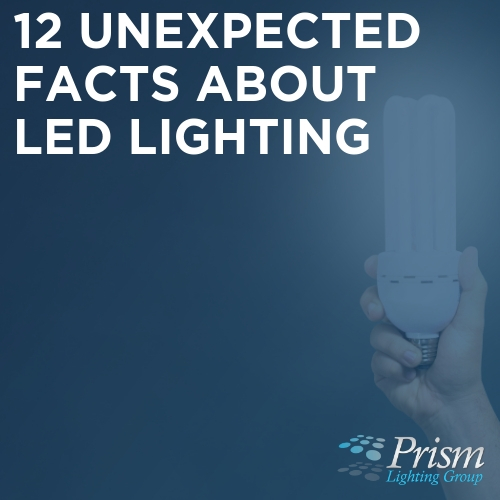- Exhibit Lighting
- Prism Original Series
- Lovo™ Edge Series
- LED Display Arm Lights
- LED Light Stands
- LED Flexible Strip Lighting
- LED Light Panels & Signage
- LED Down Lights
- High Bay LED Lighting
- LED Rigid Strip Lights
- LED Aluminium and Silcone Profile Extrusion
- Connectors & Cabling
- LED Accessories
- LED Controllers
- DMX LED Lighting
- MADRIX Lighting Control
- Programmable Lighting
- LED Lamps
- Power Supplies
- Battery Solutions
- Clearance
- More Lighting Options
- Commercial Lighting
- Retail Lighting
- Lovo™ LED Series
- What We Do
- Who We Are
- Resources

12 Unexpected Facts About LED Lighting
Tuesday, May 14th, 2019
LED Lighting plays an important role in design applications and the environmental movement. LEDs represent approximately 20% of the market due to its affordability and efficiency. That’s why it’s important to learn the facts as you begin to use LEDs. Here are 13 unexpected facts about LED Lighting that may surprise you.
- A light-emitting diode (LED) is a type of solid-state lighting that uses a semiconductor to convert electricity into light. Today’s LED bulbs can be six times more energy efficient and cut energy use by more than 80 percent.
- LEDs contain no mercury. This allows LEDs to have a much smaller environmental impact than incandescent bulbs.
- The first visible-spectrum LED was invented by Nick Holonyak, Jr., while working for GE in 1962. Since then, the technology has advanced, and costs have dropped, making LEDs a viable lighting solution. By 2030, it’s estimated that LEDs will account for 75 percent of all lighting sales.
- In 2012, about 49 million LEDs were installed in the U.S. — saving about $675 million in annual energy costs. Switching entirely to LED lights over the next two decades could save the U.S. $250 billion in energy costs. It reduces electricity consumption for lighting by almost 50 percent and avoids 1,800 million metric tons of carbon emissions.
- Seven billion pounds of greenhouse gas emissions could be reduced if every American switched out one light bulb with an LED bulb. That’s equal to removing the emissions from 648,000 cars.
- Switching every bulb at home to an LED could save as much as $6,000 over the bulbs’ life. Hawaii, anyone?
- LEDs last 13 to 22 years or up to 25 times longer than traditional light sources. If you installed an LED in your newborn’s room, it could still be running strong by the time you send him off to college.
- By 2020, 50% of all U.S. residential lighting sockets will be LED.
- LEDs don’t produce heat in the form of infrared radiation, which makes incandescent bulbs hot to the touch.
- LEDs switch on rapidly, even when cold. This is an advantage for outdoor lighting applications.
- LEDs are low-voltage light sources. LEDs generally need a constant DC voltage or current to operate optimally. The low power consumption of LEDs leads to significant energy savings. This can often drive the installation of LED-based systems.
- LEDs are very small. LEDs typical high-brightness LED chips measure 0.3 mm by 0.3 mm, while high-power devices can be 1 mm x 1 mm or larger. LEDs open many new design options, some of which were previously inconceivable.
Did any of these LED facts surprise you? Let us know!
Want to know more about LED Lighting and the different lighting products and services available for your next project? Browse our website to find the perfect lighting solution that will save you money, easy to install and energy-efficient.
Sources:
https://www.ge.com/reports/2017-earth-day-7-electric-facts-didnt-know-potential-leds/
https://www.ledsmagazine.com/articles/2005/05/fact-or-fiction-the-truth-about-leds.html
https://www.ledsmagazine.com/articles/2005/01/benefits-and-drawbacks-of-leds.html
https://www.energy.gov/articles/top-11-things-you-didnt-know-about-saving-energy-home-summer-edition
https://www.energy.gov/articles/top-8-things-you-didn-t-know-about-leds

